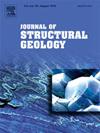Petrophysical Characterization of Metamorphic Rocks using X-ray Micro-CT data – Implications for fluid flow
IF 2.6
2区 地球科学
Q2 GEOSCIENCES, MULTIDISCIPLINARY
引用次数: 0
Abstract
The petrophysical properties (porosity and permeability) of rocks are significantly influenced by their microstructure and fabric anisotropy, which can be evaluated using X-ray micro-computed tomography (μCT). Through study of mica schists from the Singhbhum Shear Zone (Eastern India), we demonstrate the potential to perform X-ray micro-CT studies in metamorphic rocks and discuss the associated challenges in data processing. We show that automated thresholding of greyscale values from μCT data acquisition yields abnormally high porosity/permeability values in schists when compared to the values obtained from laboratory measurements of the same samples. We develop a modus operandi where the laboratory measured porosity value from an individual schist sample is used to calibrate the greyscale threshold range (designating void space) of μCT data from the same sample. This calibration is done using PACE3D numerical simulation framework that allows a multiphase-field approach, and it is shown that (a) porosities of schist derived from analysis of μCT data (post re-thresholding) fit well with laboratory measured values of respective samples and (b) anisotropy of permeability can be computed from μCT data. Permeability computed using the μCT data (post re-thresholding) vis-à-vis laboratory measurements are comparable in 4 out of 5 schist samples analysed here, when the samples are treated as a two phase system (void spaces as one phase and solid rock mass as the second phase) in PACE3D. The aberration in one schist sample is attributed to its heterogeneous layering and microstructure that comprises alternate layers of coarse and fine grain size aggregates of phyllosilicate + quartz. Re-computation of permeability by performing three-phase simulations for the above layered sample in PACE3D framework by introducing phyllosilicate as a third phase (in addition to void spaces and other mineral phases) yields results similar to the laboratory measurements. We conclude that our approach of integrating μCT data, laboratory measurement of petrophysical properties and microstructure modelling/simulation in PACE3D multiphase-field framework helps evaluate the role of rheological variations in controlling porosity/permeability. Thus this study has a bearing on enhancing knowledge about fluid flow in metamorphic rocks with possible implications for mineralization.
利用x射线微ct数据研究变质岩的岩石物理特征——流体流动的意义
岩石的微观结构和组构各向异性对岩石物性(孔隙度和渗透率)有显著影响,可通过x射线微计算机断层扫描(μCT)进行评价。通过对Singhbhum剪切带(东印度)云母片岩的研究,我们展示了在变质岩中进行x射线微ct研究的潜力,并讨论了数据处理中的相关挑战。我们发现,与实验室测量相同样品的值相比,μCT数据采集的灰度值自动阈值在片岩中产生异常高的孔隙度/渗透率值。我们开发了一种操作方法,使用实验室测量的单个片岩样品的孔隙度值来校准来自同一样品的μCT数据的灰度阈值范围(指定空隙空间)。采用允许多相场方法的PACE3D数值模拟框架进行校准,结果表明:(a) μCT数据分析(重新阈值后)得到的片岩孔隙度与各样品的实验室测量值拟合良好;(b) μCT数据可以计算出渗透率的各向异性。在PACE3D中将5个片岩样品作为两相系统(空隙为一相,固体岩体为第二相)处理时,使用μCT数据(重新阈值后)与-à-vis实验室测量值计算的渗透率在4个片岩样品中具有可比性。一个片岩样品的像差是由于其不均匀的层状结构和微观结构,包括层状硅酸盐+石英的粗粒和细粒团聚体的交替层。通过在PACE3D框架中引入层状硅酸盐作为第三相(除了空隙和其他矿物相),对上述分层样品进行三相模拟,重新计算渗透率,得到与实验室测量结果相似的结果。综上所述,在PACE3D多相场框架中整合μCT数据、岩石物理性质实验室测量和微观结构建模/模拟的方法有助于评估流变学变化在控制孔隙度/渗透率方面的作用。因此,这项研究对加强对变质岩流体流动的认识具有重要意义,并可能对成矿作用产生影响。
本文章由计算机程序翻译,如有差异,请以英文原文为准。
求助全文
约1分钟内获得全文
求助全文
来源期刊

Journal of Structural Geology
地学-地球科学综合
CiteScore
6.00
自引率
19.40%
发文量
192
审稿时长
15.7 weeks
期刊介绍:
The Journal of Structural Geology publishes process-oriented investigations about structural geology using appropriate combinations of analog and digital field data, seismic reflection data, satellite-derived data, geometric analysis, kinematic analysis, laboratory experiments, computer visualizations, and analogue or numerical modelling on all scales. Contributions are encouraged to draw perspectives from rheology, rock mechanics, geophysics,metamorphism, sedimentology, petroleum geology, economic geology, geodynamics, planetary geology, tectonics and neotectonics to provide a more powerful understanding of deformation processes and systems. Given the visual nature of the discipline, supplementary materials that portray the data and analysis in 3-D or quasi 3-D manners, including the use of videos, and/or graphical abstracts can significantly strengthen the impact of contributions.
 求助内容:
求助内容: 应助结果提醒方式:
应助结果提醒方式:


